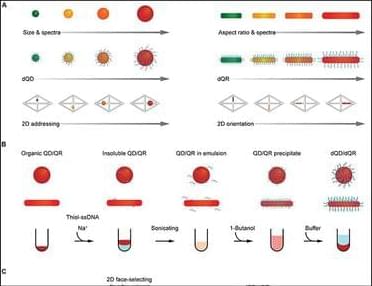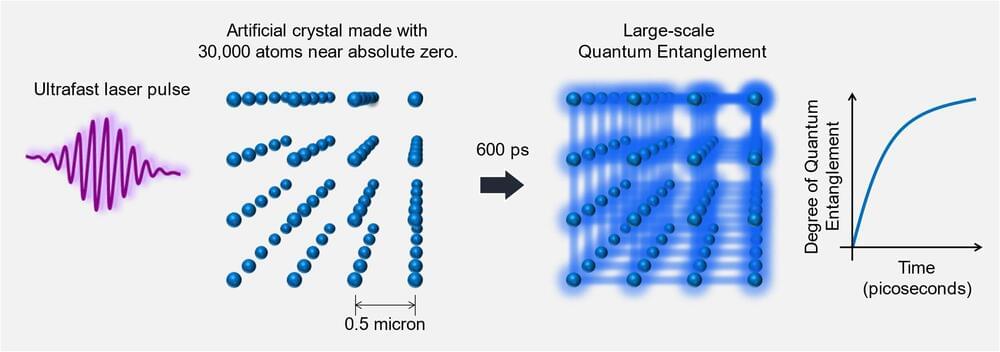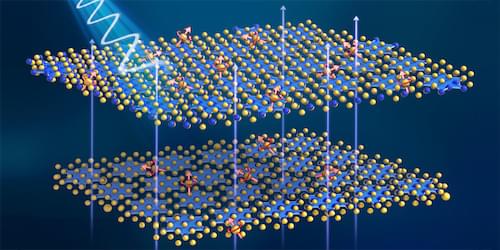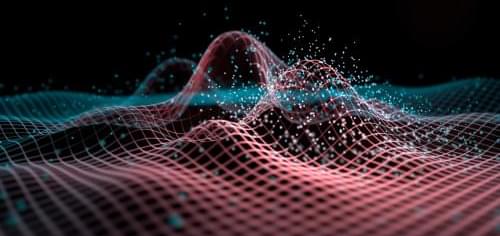While the Quantum Computer race is heating up with companies such as Atlantic Quantum Innovations joining the race, Google has published a plan to make Quantum Computers usable for everyday consumers by 2029. This is in hopes of revolutionizing Healthcare, finding room temperature superconductors, enabling with like artificial general intelligence through quantum AI and increasing supercomputer performance a million times. In this video, we’re exploring all of these secret projects and other Quantum Computing Companies.
–
TIMESTAMPS:
00:00 CPU’s, GPU’s and now QPU’s.
01:14 Google’s Secret Project.
04:36 Other Quantum Computer Companies.
07:17 Fastest Quantum Computer today.
–
#google #quantum #future
Category: quantum physics – Page 468

Ultrafast dense DNA functionalization of quantum dots and rods for scalable 2D array fabrication with nanoscale precision
Abstract: Full Publication #OpenAccess.
Scalable fabrication of two-dimensional (2D) arrays of quantum dots (QDs) and quantum rods (QRs) with nanoscale precision is required for numerous device applications. However, self-assembly–based fabrication of such arrays using DNA origami typically suffers from low yield due to inefficient QD and QR DNA functionalization. In addition, it is challenging to organize solution-assembled DNA origami arrays on 2D device substrates while maintaining their structural fidelity. Here, we reduced manufacturing time from a few days to a few minutes by preparing high-density and rehydration process. We used a surface-assisted large-scale assembly (SALSA) method to construct 2D origami lattices directly on solid substrates to template QD and QR 2D arrays with orientational control, with overall loading yields exceeding 90%. Our fabrication approach enables the scalable, high fidelity manufacturing of 2D addressable QDs and QRs with nanoscale orientational and spacing control for functional 2D photonic devices.
Dehydration and surface-assisted assembly enable rapid, scalable quantum dot and quantum rod 2D arrays with nanoscale precision.

My predictions about Artificial Super Intelligence (ASI)
Patreon: https://www.patreon.com/daveshap.
LinkedIn: https://www.linkedin.com/in/dave-shap-automator/
Consulting: https://www.daveshap.io/Consulting.
GitHub: https://github.com/daveshap.
Medium: https://medium.com/@dave-shap.
00:00 — Introduction.
00:38 — Landauer Limit.
02:51 — Quantum Computing.
04:21 — Human Brain Power?
07:03 — Turing Complete Universal Computation?
10:07 — Diminishing Returns.
12:08 — Byzantine Generals Problem.
14:38 — Terminal Race Condition.
17:28 — Metastasis.
20:20 — Polymorphism.
21:45 — Optimal Intelligence.
23:45 — Darwinian Selection “Survival of the Fastest“
26:55 — Speed Chess Metaphor.
29:42 — Conclusion & Recap.
Artificial intelligence and computing power are advancing at an incredible pace. How smart and fast can machines get? This video explores the theoretical limits and cutting-edge capabilities in AI, quantum computing, and more.
We start by looking at the Landauer Limit — the minimum energy required to perform computation. At room temperature, erasing just one bit of information takes 2.85 × 10^−21 joules. This sets limits on efficiency.
Quantum computing offers radical improvements in processing power by utilizing superposition and entanglement. Through quantum parallelism, certain problems can be solved exponentially faster than with classical computing. However, the technology is still in early development.
The human brain is estimated to have the equivalent of 1 exaflop processing power — a billion, billion calculations per second! Yet it uses just 20 watts, making it vastly more energy-efficient than today’s supercomputers. Some theorize the brain may use quantum effects, but this is speculative.


Ultrafast quantum simulation of large-scale quantum entanglement
A research group led by Professor Kenji Ohmori at the Institute for Molecular Science, National Institutes of Natural Sciences are using an artificial crystal of 30,000 atoms aligned in a cubic array with a spacing of 0.5 micron, cooled to near absolute zero temperature. By manipulating the atoms with a special laser light that blinks for 10 picoseconds, they succeeded in executing quantum simulation of a model of magnetic materials.
Their novel “ultrafast quantum computer” scheme demonstrated last year was applied to quantum simulation. Their achievement shows that their novel “ultrafast quantum simulator” is an epoch-making platform, as it can avoid the issue of external noise, one of the biggest concerns for quantum simulators. The “ultrafast quantum simulator” is expected to contribute to the design of functional materials and the resolution of social problems.
Their results were published online in Physical Review Letters.

Quantum Material Exhibits “Non-Local” Behavior That Mimics Brain Function
We often believe computers are more efficient than humans. After all, computers can complete a complex math equation in a moment and can also recall the name of that one actor we keep forgetting. However, human brains can process complicated layers of information quickly, accurately, and with almost no energy input: recognizing a face after only seeing it once or instantly knowing the difference between a mountain and the ocean. These simple human tasks require enormous processing and energy input from computers, and even then, with varying degrees of accuracy.
Creating brain-like computers with minimal energy requirements would revolutionize nearly every aspect of modern life. Funded by the Department of Energy, Quantum Materials for Energy Efficient Neuromorphic Computing (Q-MEEN-C) — a nationwide consortium led by the University of California San Diego — has been at the forefront of this research.
UC San Diego Assistant Professor of Physics Alex Frañó is co-director of Q-MEEN-C and thinks of the center’s work in phases. In the first phase, he worked closely with President Emeritus of University of California and Professor of Physics Robert Dynes, as well as Rutgers Professor of Engineering Shriram Ramanathan. Together, their teams were successful in finding ways to create or mimic the properties of a single brain element (such as a neuron or synapse) in a quantum material.



Breakthrough Prize for Quantum Field Theorists
The 2024 Breakthrough Prize in Fundamental Physics goes to John Cardy and Alexander Zamolodchikov for their work in applying field theory to diverse problems.
Many physicists hear the words “quantum field theory,” and their thoughts turn to electrons, quarks, and Higgs bosons. In fact, the mathematics of quantum fields has been used extensively in other domains outside of particle physics for the past 40 years. The 2024 Breakthrough Prize in Fundamental Physics has been awarded to two theorists who were instrumental in repurposing quantum field theory for condensed-matter, statistical physics, and gravitational studies.
“I really want to stress that quantum field theory is not the preserve of particle physics,” says John Cardy, a professor emeritus from the University of Oxford. He shares the Breakthrough Prize with Alexander Zamolodchikov from Stony Brook University, New York.